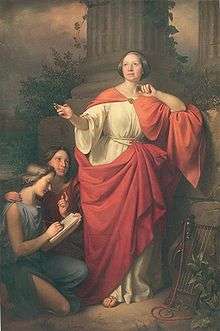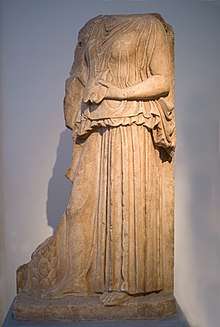Diotima of Mantinea

Diotima of Mantinea (/ˌdaɪəˈtaɪmə/; Greek: Διοτίμα; Latin: Diotīma) was an ancient Greek priestess/prophet and philosopher[1] thought to have lived circa 440 B.C.E., who plays an important role in Plato's Symposium. In the dialogue, her ideas are the origin of the concept of Platonic love. Her historicity and relation to Socrates, however, are subjects of much debate.
Identity
The name Diotima means "Zeus Honor", either in the active sense of a woman who honors Zeus, or in the passive sense of a woman honored by Zeus.[2]
She was said to be from the Peloponnesian city of Mantinea, which allied itself with Sparta during the Peloponnesian War. The Greek form of this place, Mantinike, appears to contain the root "mantis", meaning "prophet, seer", and strongly suggests that Diotima was herself a prophetess, or at least somehow associated with prophecy. Diotima Mantinike thus would sound like "Diotima from Prophet-victory". Socrates provides additional significant information for his fellow symposiasts about Diotima Mantinike that hints at her victorious prophetic powers.[2]
Since the only contemporaneous source concerning her is Plato, doubts have been raised about whether she was a real historical personage or merely a fictional creation; however, nearly all of the characters named in Plato's dialogues have been found to correspond to real people living in ancient Athens.[3]
Plato was thought by most 19th and early 20th century scholars to have based Diotima on Aspasia, the mistress of Pericles, so impressed was he by her intelligence and wit. However, Aspasia appears under her own name in Plato's dialogue Menexenus, and some scholars have convincingly argued that Plato did not use false names: therefore, Diotima could be a historical figure.[4]
A first century bronze relief found in Pompeii depicts Socrates and an unnamed female figure, along with a winged Eros; although some have supposed the seated woman in the image to be Diotima, others have argued her appearance (notably a necklace) would suggest she is in fact more likely to be Aphrodite or Aspasia. It should be noted that writings from the second through the fifth centuries A.D., refer to Diotima as a real person, although Plato is probably their only basis for this. The suggestion that she was a fictional creation was not introduced until the 15th century (notably by Marsilio Ficino), probably based on the fact that she was a woman[1]; however, this plausible hypothesis (with numerous parallels in the study of Platonic dialogues, for instance Callicles in the Gorgias) was in fact put forward because Diotima is not mentioned by contemporary or near-contemporary sources and because her very name and origin could be understood as symbolic.
Role in Symposium
In Plato's Symposium the members of a party discuss the meaning of love. Socrates says that in his youth he was taught "the philosophy of love" by Diotima, who was a seer or priestess. Socrates also claims that Diotima successfully postponed the Plague of Athens. In a dialogue that Socrates recounts at the symposium, Diotima gives Socrates a genealogy of Love (Eros), stating that he is the son of "resource and poverty". In her view, love is a means of ascent to contemplation of the Divine. For Diotima, the most correct use of love of other human beings is to direct one's mind to love of Divinity.[5] The beautiful beloved inspires the mind and the soul and directs one's attention to spiritual things. One proceeds from recognition of another's beauty, to appreciation of Beauty as it exists apart from any individual, to consideration of Divinity, the source of Beauty, to love of Divinity.

Influence and use of name
"Diotima" has often been used as a title for philosophical or artistic projects, journals, essays, etc.:
- Polish writer Jadwiga Łuszczewska (1834–1908) used the pen name Diotima (Deotyma).
- German poet Friedrich Hölderlin used Diotima as an alias for Susette Borkenstein Gontard, who inspired him to write Hyperion. In this work, the fictitious first-person author Hyperion addresses letters to his friends Bellarmin and Diotima.
- Italian composer Luigi Nono used her name as part of the title of his string quartet: Fragmente-Stille, an Diotima, including quotations from Hölderlin's letters to Diotima from Hyperion in the work.
- Diotima is the namesake of one of the main female protagonists in The Man Without Qualities by Robert Musil
- Diotima was the name of Leni Riefenstahl's character in the silent film, Der Heilige Berg.
- Diotima appears in the short poem "Irpen'" by Boris Pasternak.
- Diotima teaches Socrates and Giannina the meaning of love in Giannina Braschi's postcolonial dramatic novel United States of Banana.
- Diotima of Mantinea is one of the two main characters in the novels The Pericles Commission,The Ionia Sanction and Sacred Games by Gary Corby.
- Diotima is the name of New York-based experimental black metal band Krallice's third album.
- Asteroid 423 Diotima is named after her.
- Diotima is used in the sorority Beta Sigma Phi.
- Skirmishes for Diotima is the name of the seventh track of The Hyperion Machine, the tenth album released by the Luxembourgish neofolk band ROME.
See also
Notes
- 1 2 Waithe, Mary Ellen (1987). "Diotima of Mantinea". In Waithe, Mary Ellen. A History of Women Philosophers: Volume I: Ancient Women Philosophers, 600 BC–500 AD. Dordrecht: Martinus Nijhoff. pp. 83–116. ISBN 9789024733484. Retrieved October 10, 2018.
- 1 2 Evans, Nancy. "Diotima and Demeter as Mystagogues in Plato's Symposium." Hypatia, vol. 21, no. 2, 2006, pp. 1–27. http://www.jstor.org/stable/3810989.
- ↑ Ruby Blondell The Play of Character in Plato's Dialogues, Cambridge University Press, 2002, p.31
- ↑ Wider, Kathleen. "Women philosophers in the Ancient Greek World: Donning the Mantle". Hypatia vol 1 no 1 Spring 1986. Part of her argument focuses on the point that all scholars who argued "for" a fictitious Diotima were male, and most used as a starting point Smith's uncertainty of her actual existence (Smith, Dictionary of Greek and Roman Biography and Mythology, 1870).
- ↑ Plato, Symposium, 210a–212b
References
- Navia, Luis E., Socrates, the man and his philosophy, pp. 30, 171. University Press of America ISBN 0-8191-4854-7.
- Evans, Nancy. “Diotima and Demeter as Mystagogues in Plato's Symposium.” Hypatia, vol. 21, no. 2, 2006, pp. 1–27. http://www.jstor.org/stable/3810989.